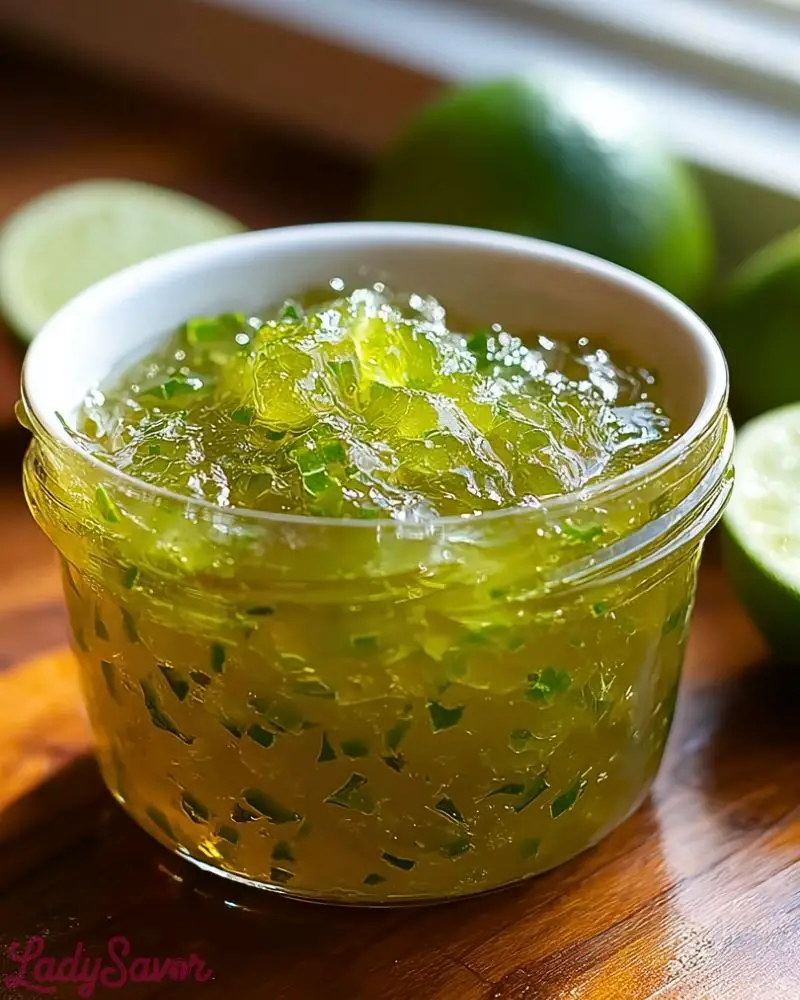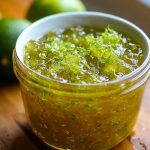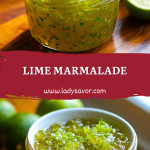I recently discovered the perfect balance between tartness and sweetness with lime marmalade, and I can’t get enough of it. The vibrant green hue of fresh limes combined with the tangy, yet sweet, spread is absolutely irresistible. I decided to give it a try, and now it’s my go-to homemade treat to pair with just about anything—whether it’s on toast, as a topping for desserts, or even as a marinade for savory dishes. It’s the perfect blend of flavors that can bring a refreshing twist to your everyday meals.

Not only is lime marmalade delicious, but it’s surprisingly easy to make. With just a few ingredients and simple steps, you can create a homemade preserve that’s far superior to store-bought versions. The fresh lime zest adds a fragrant depth of flavor, and when the sugar and lime juice meld together, it’s pure perfection in a jar. Whether you’re new to marmalade or a seasoned pro, this recipe will have you hooked in no time.
Why You’ll Love This Lime Marmalade
Lime marmalade is an excellent choice if you love citrus-flavored spreads with a touch of sweetness and zest. The combination of fresh limes and sugar creates a bright, tangy marmalade that’s perfect for a variety of uses. From slathering it on toast in the morning to incorporating it into your favorite dishes for an extra zing, this marmalade offers a unique twist. You’ll also appreciate how easy it is to make and how long it lasts, so you can enjoy it for weeks to come. It’s a true kitchen staple that adds a punch of flavor wherever it’s used.
What Kind of Limes Should I Use for Marmalade?
When making lime marmalade, the quality of your limes plays a huge role in the final flavor. I recommend using fresh, ripe limes that are fragrant and have a firm texture. Key limes are often preferred for their tartness and vibrant flavor, but regular Persian limes will work just as well, especially if you’re looking for a larger quantity. Whichever variety you choose, make sure they’re fresh and not overripe, as that can affect the marmalade’s balance of sweetness and tartness.
Options for Substitutions
While the traditional lime marmalade recipe calls for fresh limes, there are a few substitutions you can experiment with, depending on what you have available or your personal preferences:
- Lemon Marmalade: If you don’t have limes, lemon works beautifully in this recipe. The tangy citrus flavor will still shine through.
- Grapefruit Marmalade: For a more complex, slightly bitter flavor, you could swap the limes for grapefruits, though the taste will be quite different.
- Orange Marmalade: If you’re looking for a sweeter and less tangy alternative, oranges are a great option.
- Sugar Substitutes: You can experiment with alternatives like honey, agave syrup, or a low-sugar pectin to adjust the sweetness levels based on your dietary needs.
Each of these substitutions will slightly change the character of your marmalade, but they can be delicious in their own right!
Ingredients for Lime Marmalade
-
Limes
Fresh limes are the star ingredient in this marmalade. Their juice and zest provide the perfect balance of tartness and freshness that defines the marmalade’s flavor. The zest will also add a lovely fragrance to the spread. -
Sugar
Sugar helps to balance the tartness of the limes and acts as the preservative that will ensure your marmalade can be stored for a longer time. Granulated sugar is typically used for its ability to dissolve well and set the marmalade. -
Water
Water helps to cook down the limes and sugar into a syrupy consistency before it sets into marmalade. It also allows the natural flavors to meld together. -
Pectin
Pectin is crucial for helping the marmalade set. It acts as a gelling agent that ensures your marmalade isn’t too runny. You can use powdered pectin or liquid pectin depending on availability. -
Lemon Juice
Adding a bit of lemon juice helps to balance the acidity of the limes and adds a layer of depth to the flavor. It also works in conjunction with the pectin to help the marmalade thicken properly.
These simple ingredients combine to create a bright, tangy, and sweet spread that’s bursting with citrus goodness!

Step 1: Prepare the Limes
Start by thoroughly washing your limes. Zest the limes first, using a microplane or fine grater, to collect all the aromatic zest. After zesting, slice the limes in half and juice them, removing any seeds as you go. You should have about 1 cup of lime juice.
Step 2: Combine Ingredients
In a large pot, combine the freshly squeezed lime juice, zest, water, and lemon juice. Stir in the sugar and pectin, mixing well to ensure the sugar dissolves completely. This mixture will serve as the base for your marmalade.
Step 3: Cook the Marmalade
Place the pot over medium-high heat and bring the mixture to a boil. Stir frequently to prevent any burning at the bottom. Once the mixture reaches a boil, reduce the heat to a simmer. Continue to cook for about 45 minutes to 1 hour, occasionally stirring, until the marmalade thickens and reaches your desired consistency.
Step 4: Test for Doneness
To check if the marmalade is done, take a small spoonful of the mixture and place it on a chilled plate. Let it sit for a minute, then run your finger through it. If the marmalade wrinkles and holds its shape, it’s ready. If it’s still runny, continue simmering for a little longer.
Step 5: Jar and Seal the Marmalade
Once your marmalade has thickened to your liking, remove it from the heat and let it cool slightly. Carefully ladle the hot marmalade into sterilized jars, leaving about 1/4 inch of space at the top. Seal the jars with sterilized lids while the marmalade is still hot, and let them cool to room temperature before storing.
With these simple steps, you’ll have homemade lime marmalade that’s ready to enjoy!
How Long to Cook the Lime Marmalade
The total cooking time for lime marmalade typically takes between 45 minutes to 1 hour. The key is to cook the mixture until it thickens to your desired consistency. Keep an eye on it, stirring occasionally to prevent burning, and don’t rush the process. The marmalade should reduce to a syrupy texture that’s not too runny but still spreadable. If you want a firmer set, you can simmer a little longer, but always test the consistency using the cold plate method to avoid overcooking.
Tips for Perfect Lime Marmalade
- Use fresh, ripe limes: The fresher the limes, the more vibrant and tangy your marmalade will taste.
- Don’t skip the zest: The zest is essential for adding depth to the flavor of the marmalade. It releases natural oils that make the marmalade fragrant and flavorful.
- Check consistency often: Marmalade can go from liquid to jam-like quickly, so make sure to test it periodically to ensure you get the texture you want.
- Sterilize jars: For the marmalade to last longer, ensure your jars are clean and sterilized. This will help prevent any bacteria or spoilage and keep your marmalade fresh for weeks.
With these tips, your lime marmalade will turn out perfectly every time!
Watch Out for These Mistakes While Cooking
-
Overcooking the Marmalade
If you leave the marmalade on the heat for too long, it can become overly thick or even turn into a hard candy-like texture once it cools. Always test the consistency as you cook to ensure it reaches the right thickness. -
Not Removing the Pith
If you zest the limes but leave too much of the white pith, it can make your marmalade bitter. Be sure to zest carefully, avoiding the pith to keep the flavor balanced. -
Not Stirring Enough
Stirring the marmalade regularly helps to avoid burning at the bottom of the pan and ensures even cooking. If you let it sit for too long without stirring, you risk uneven cooking or burning. -
Skipping the Testing Step
It’s easy to assume that the marmalade is ready once it thickens, but always test it by placing a spoonful on a cold plate. It’s the best way to know for sure that it’s set to the right consistency. -
Not Sterilizing Jars Properly
If your jars aren’t sterilized properly, you run the risk of contamination, which could lead to spoilage. Make sure to sterilize the jars in boiling water or the oven before filling them with marmalade.
What to Serve With Lime Marmalade?
1. Toast and Butter
Spread your homemade lime marmalade on a warm, buttered slice of toast for a delightful breakfast treat.
2. Yogurt
Stir a spoonful of lime marmalade into plain yogurt to give it a refreshing, citrusy twist.
3. Cheese Board
Lime marmalade pairs wonderfully with cheeses, particularly sharp ones like cheddar or brie. It adds a unique touch to any cheese platter.
4. Pancakes or Waffles
Drizzle lime marmalade over pancakes or waffles instead of traditional syrup for a zesty change.
5. Grilled Meats
Use lime marmalade as a glaze or marinade for grilled chicken, pork, or fish to add a tangy citrus flavor to your savory dishes.
6. Desserts
Lime marmalade can be swirled into desserts like cakes, ice creams, or cheesecakes for a fresh citrus burst.
7. Scones
Spread lime marmalade on freshly baked scones for a delightful pairing at teatime.
8. Ice Cream
Serve lime marmalade alongside or on top of vanilla or coconut ice cream for a refreshing, tropical flavor.
Storage Instructions
Once your lime marmalade has cooled, it can be stored in sealed jars for up to 3 to 4 weeks in the refrigerator. If you’ve properly sterilized the jars and sealed them while the marmalade is still hot, it should last even longer. For longer storage, you can also can the marmalade using a water bath process, which allows it to stay fresh for up to a year when stored in a cool, dark place. Just be sure to check the seal of the jars before using them; if the lid doesn’t pop when pressed, discard it.
Estimated Nutrition
While lime marmalade is delicious, it is a sweet treat and should be enjoyed in moderation. Here’s an estimated breakdown for one tablespoon of lime marmalade:
- Calories: 50-60
- Carbohydrates: 13-15g
- Sugar: 13-14g
- Fat: 0g
- Sodium: 0mg
- Fiber: 0g
- Protein: 0g
The nutritional content may vary slightly depending on the specific ingredients and the amount of sugar used, but this gives you a good idea of the caloric and carbohydrate intake per serving.
Frequently Asked Questions
1. Can I use other citrus fruits instead of lime?
Yes! You can use lemons, oranges, or even grapefruits. Keep in mind, each citrus fruit will give the marmalade a different flavor profile, but they all work well with the same basic recipe.
2. Can I make lime marmalade without pectin?
Yes, you can. While pectin helps the marmalade set, it’s possible to make marmalade without it by allowing it to cook down longer until it naturally thickens. Just be prepared for a longer cooking time.
3. How do I know if the marmalade has set properly?
The best way to test the consistency is by placing a spoonful of the marmalade on a cold plate. Let it cool for a minute, then run your finger through it. If it wrinkles and holds its shape, it’s done.
4. Can I adjust the sweetness of the marmalade?
Absolutely! If you prefer a less sweet marmalade, simply reduce the sugar amount to your taste. Just remember that sugar also acts as a preservative, so reducing it may shorten the shelf life.
5. How long does lime marmalade last?
Lime marmalade can last up to 3-4 weeks in the refrigerator if stored in sealed jars. If properly canned, it can last up to a year when stored in a cool, dark place.
6. Can I use sugar substitutes for this recipe?
Yes, you can use sugar substitutes like stevia, honey, or agave syrup. Keep in mind that these may affect the texture and taste, and you might need to experiment with the proportions to get the right consistency.
7. Can I freeze lime marmalade?
While freezing marmalade is possible, the texture may change slightly upon thawing. If you choose to freeze it, use freezer-safe jars and leave space at the top for expansion.
8. Can I add other ingredients to the marmalade, like ginger or vanilla?
Yes! You can add fresh ginger, vanilla extract, or even a pinch of salt to enhance the flavor of your lime marmalade. Experiment with different flavors to find your perfect blend.
Conclusion
Making homemade lime marmalade is a rewarding experience that results in a bright, zesty spread that can be enjoyed in countless ways. Whether you’re spreading it on toast, pairing it with cheese, or using it as a topping for desserts, this marmalade adds a refreshing citrus kick to anything it touches. With a few simple ingredients and easy steps, you can create a batch of lime marmalade that’s perfect for gifting or enjoying all to yourself. Don’t hesitate to experiment with different citrus fruits or flavors to make it your own!

Lime Marmalade
- Total Time: 1 hour 5 minutes
- Yield: About 4 cups 1x
Description
Lime marmalade is a vibrant, tangy-sweet spread made from fresh limes, sugar, and a touch of lemon juice. This homemade marmalade offers a refreshing citrus burst and is perfect for spreading on toast, pairing with cheese, or even adding a zesty touch to your favorite desserts. With its easy preparation and long shelf life, it’s a must-have in your kitchen.
Ingredients
1 cup lime juice
2 tablespoons lime zest
4 cups granulated sugar
2 cups water
2 tablespoons lemon juice
1 packet powdered pectin (or as instructed on packaging)
Instructions
1. Thoroughly wash the limes and zest them carefully to avoid the bitter pith.
2. Slice the limes in half and juice them, removing any seeds. You should have about 1 cup of lime juice.
3. In a large pot, combine the lime juice, lime zest, water, lemon juice, sugar, and pectin. Stir well to dissolve the sugar.
4. Bring the mixture to a boil over medium-high heat, stirring frequently. Once it boils, reduce the heat to a simmer.
5. Simmer the marmalade for 45 minutes to 1 hour, stirring occasionally, until it thickens to your desired consistency.
6. To test for doneness, place a spoonful of the mixture on a cold plate. If it wrinkles when pushed with your finger, it’s ready.
7. Once thickened, remove the marmalade from heat and let it cool slightly.
8. Ladle the marmalade into sterilized jars, leaving about 1/4 inch at the top. Seal the jars and let them cool completely before storing.
Notes
Prep time: 20 minutes
Cook time: 45 minutes – 1 hour
Yield: About 4 cups
Category: Preserve / Spread
- Prep Time: 20 minutes
- Cook Time: 45 minutes
- Category: Preserve / Spread
Nutrition
- Serving Size: 1 tablespoon
- Calories: 55
- Sugar: 14g
- Sodium: 0mg
- Fat: 0g
- Saturated Fat: 0g
- Unsaturated Fat: 0g
- Trans Fat: 0g
- Carbohydrates: 15g
- Fiber: 0g
- Protein: 0g
- Cholesterol: 0mg

